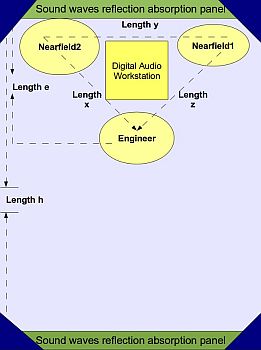c.1.) Bass is louder than the mid and high frequencies.
c.2.) Bass is dropping in volume or not even throughout the bass frequency range.
c.2.) Either the mid or high frequencies are very harsh.
d.) Other of my most favorite test tones can be found here.
In that page, you can find a lot of test tones like to evaluate the bass response in detail, panning accuracy; etc. If you are confident that your room response is now flat or accurate; then it probably solves 70% of the mixing translation accuracy issues.
Get used to listening good music at mixing position
It starts with proper ear training for audio mixing. Once you are confident with your listening skills; try playing some professionally produced recordings and mixes.
2.) Listen to them at a moderate volume and get to feel at the following elements:
a.) Bass, mid and high frequency response.
b.) Compression of instruments.
c.) Reverberation of instruments.
I suggest to listen more commercial and professional CD’s at your targeted genre so that you will know how these tracks should sound like when its time for you to mix projects. For example listening to rock music today reveals that the drums and guitars are loud and heavy. Then the vocals are little buried in the mix. This is how rock music is mixed today.
Monitor at low volume- Rest your ear
It’s tempting to monitor very loudly when mixing. In my experience, the results are not good for two reasons:
a.) It fatigues my ear very often. In long term, this can permanently damage your ear.
b.) I find it hard to balance instrument levels at a very loud volume.
Monitor at a volume which you find very comfortable. For example in my home studio setup, I switch M-audio BX5a at their full volume. But in the audio interface, I switch the monitor output knob between 35% to 45% maximum so the volume that comes from the monitors are moderately soft.
I mix not more than 3 hours straight and I rest my ear. For critical mixing projects, I will not finish the mix in the whole day; instead I will continue it the next day. Following this technique; you will be able to monitor very accurately if your ears are fresh and not fatigued.
Play your mix in other audio equipments
Finally once you made a successful mix down, you can assess the results by playing your mix with different types of audio players in your home. This will confirm the accuracy of your mix. If the mix sounds good when it gets played on other audio players, chances are it will sound good anywhere. Do not forget to listen the mix down in this following setup to confirm translation accuracy:
a.) Using headphones – it will reveal some problems that you cannot monitor easily with near field monitors (such as panning,reverb and noise).
b.) Audio player with a subwoofer – it will reveal bass response related issues.
c.) Cassette player without bass –it will reveal mid to high frequency response issues.
d.) Using mono audio player – it will reveal phase related issues.
Content last updated on August 6, 2012









No responses yet